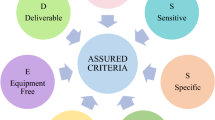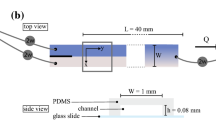Abstract
Two electrical mechanisms for manipulating particles and fluids, dielectrophoresis (DEP) and liquid dielectrophoresis (LDEP), are integrated in a microfluidic chip for creating the single-particle environment. The fluid is activated by LDEP with a 100-kHz/240-Vpp signal. When the single polystyrene bead approaches the trapping area, positive DEP force is utilized to capture and immobilize the bead. After trapping the bead, the process of liquid cutting and droplet creation is employed to create a droplet containing a single bead by LDEP with a 100-kHz/320-Vpp signal.






Similar content being viewed by others
References
Altschuler SJ, Wu LF (2010) Cellular heterogeneity: do differences make a difference? Cell 141:559–563
Andersson H, Wijngaart WVD, Nilsson P, Enoksson P, Stemme G (2001) A valve-less diffuser micropump for microfluidic analytical systems. Sens Actuators, B 72:259–265
CRC Handbook of Chemistry and Physics
Chen CH, Tsai SL, Chen MK, Jang LS (2011) Effects of applied frequency and fluid conductivity on minimum actuation voltage of aqueous liquids using EWOD and LDEP. Sens Actuators, B 159:321–327
Cho SK, Zhao Y, Kim CJ (2007) Concentration and binary separation of micro particles for droplet-based digital microfluidics. Lab Chip 7:490–498
Diggle SP, Gardner A, West SA, Griffin AS (2007) Evolutionary theory of bacterial quorum sensing: when is a signal not a signal? Philos Trans R Soc B 362:1241–1249
Dow M (2007) Diversification of the function of cell-to-cell signaling in regulation of virulence within plant pathogenic xanthomonads. Sci Signal 1(21):Pe23
Duffy DC, Schueller OJA, Brittain ST, Whitesides GM (1999) Rapid prototyping of microfluidic switches in poly(dimethyl siloxane) and their actuation by electroosmotic flow. J Micromech Microeng 9:211–217
Fan SK, Huang PW, Wang TT, Peng YH (2008) Cross-scale electric manipulations of cells and droplets by frequency-modulated dielectrophoresis and electrowetting. Lab Chip 8:1325–1331
Jang LS, Hsu CY, Chen CH (2009a) Effect of electrode geometry on performance of EWOD device driven by battery-based system. Biomed Microdevices 11:1029–1036
Jang LS, Huang PH, Lan KC (2009b) Single-cell trapping utilizing negative dielectrophoretic quadrupole and microwell electrodes. Biosens Bioelectron 24:3637–3644
Jones TB (1995) Electromechanics of particles. Cambridge University Press, Cambridge
Jones TB, Gunji M, Washizu M, Feldman MJ (2001) Dielectrophoretic liquid actuation and nanodroplet formation. J Appl Phys 89:1441–1448
Kobel S, Valero A, Latt J, Renaud P, Lutolf M (2010) Optimization of microfluidic single cell trapping for long-term on-chip culture. Lab Chip 10:857–863
Melai J, Salm C, Smits S, Visschers J, Schmitz J (2009) The electrical conduction and dielectric strength of SU-8. J Micromech Microeng 19:065012
Morgan H, Green NG (2003) AC electrokinetics: colloids and nanoparticles. Research Studies Press Ltd., Baldock
Pal R, Yang M, Johnson BN, Burke DT, Burns MA (2004) Phase change microvalve for integrated devices. Anal Chem 76:3740–3748
Pohl HA (1978) Dielectrophoresis. Cambridge University Press, Cambridge
Pollack MG, Fair RB, Shenderov AD (2000) Electrowetting-based actuation of liquid droplets for microfluidic applications. Appl Phys Lett 77(11):1725–1726
Prins MWJ, Welters WJJ, Weekamp JW (2001) Fluid control in multichannel structures by electrocapillary pressure. Science 291:277–280
Ramos A, Morgan H, Green NG, Castellanos A (1998) AC electrokinetics: a review of forces in microelectrode structures. J Phys D Appl Phys 31:2338–2353
Shah GJ, Veale JL, Korin Y, Reed EF, Gritsch HA, Kim CJ (2010) Specific binding and magnetic concentration of CD8+ T-lymphocytes on electrowetting-on-dielectric platform. Biomicrofluidics 4(4):044106
Trosko JE, Ruch RJ (1998) Cell–cell communication in carcinogenesis. Frontiers Biosci 3:d208–d236
Woodson HH, Melcher JR (1968) Electromechanical dynamics. Wiley, New York
Zhang H, Liu KK (2008) Optical tweezers for single cells. J R Soc Interface 5:671–690
Acknowledgments
This study was financially supported by the National Science Council (NSC 101-2628-E-006-006) and made use of shared facilities provided under the Program of Top 100 Universities Advancement funded by the Ministry of Education in Taiwan. The authors would like to thank the Center for Micro/Nano Science and Technology at National Cheng Kung University for access granted to major equipment throughout the duration of this study and for their general technical support.
Author information
Authors and Affiliations
Corresponding author
Rights and permissions
About this article
Cite this article
Chen, CH., Chen, MK., Wang, MH. et al. Creation of single-particle environment by positive dielectrophoresis and liquid dielectrophoresis. Microfluid Nanofluid 16, 525–532 (2014). https://doi.org/10.1007/s10404-013-1244-3
Received:
Accepted:
Published:
Issue Date:
DOI: https://doi.org/10.1007/s10404-013-1244-3




